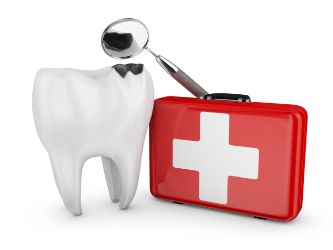
Unfortunately, there are many reasons that sudden dental pain can occur. And in the panic of the moment, it can be hard to know if you need to see an emergency dentist (or even go to the hospital). Understandably, no one wants to see a dentist or doctor unless it’s really necessary! Having said that, some situations simply shouldn’t be ignored. Keep reading to learn how to spot a true emergency and how to handle the situation until you can get professional care.
Is This a True Emergency?
All of the following are signs that you need dental care as soon as possible:
- A painful broken tooth or filling– If you’re in pain, it goes without saying that you’ll want to seek out care. But even if you’re notin pain, a broken tooth is more susceptible to breaking again, so see a dentist as soon as you can to have it looked at.
- Swelling– Facial swelling or a pimple-like bump on your gums can indicate a severe cavity or infection that can actually be life-threatening in rare cases if left untreated.
- Severe pain– If you have pain that keeps you from eating, sleeping, or going to work, call an emergency dentist right away.
Should You Go To the Hospital?
Some circumstances require medical treatment before you see a dentist. If you have severe facial cuts, heavy bleeding that doesn’t subside after applying pressure for 15 minutes, or if you think you’ve broken your jaw, go to the ER or an urgent care center first. A dentist can do any dental work that’s necessary later on.
How Can You Handle the Most Common Dental Emergencies?
Unless you need medical attention, your first step is to call an emergency dentist right away. They’ll schedule the earliest appointment and advise you on handling your specific emergency. You can also do the following to manage your pain and minimize any damage to your teeth until you’re seen:
- Knocked-out tooth– Do your best to be seen within one hour (if you can’t see a dentist, go to the ER). Only handle your tooth by the crown instead of the root and gently rinse it off before placing it back in its socket, facing the right way. If that’s not possible, put the tooth in a glass of milk or water, or hold it in your cheek pouch. Make sure the tooth stays moist.
- Broken tooth or filling– First, rinse out your mouth with lukewarm water. For pain, apply a cold compress to the outside of your cheek and take over-the-counter pain medication. If there are any sharp edges, use dental wax from the store to cover them.
- Severe toothache, abscess or swelling– Again, since this is often a sign of an infection, be sure to get care as soon as you can. Until then, swish with lukewarm salt water every few hours until your visit and take over-the-counter pain medication as directed.
No one wants to deal with a dental emergency. But since they can occur to anyone (at any time), your best bet is to be prepared!
About the Author
Dr. Bradley Mitchell is a general and emergency dentist and a graduate of the dental program at the University of Oklahoma. He makes emergency care a priority and is always just a phone call away. If you have any questions or think you’re having a dental emergency, he can be reached via his website or at (405) 755-2670.



